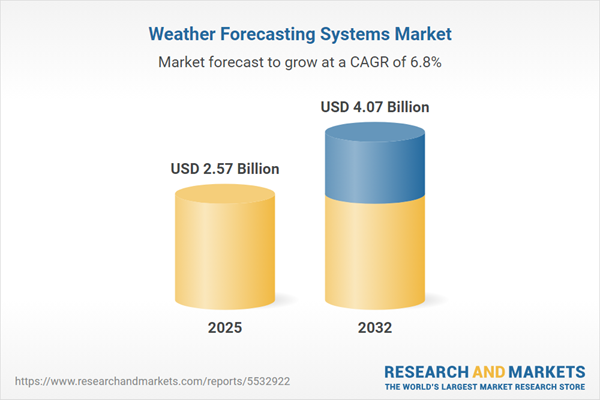Speak directly to the analyst to clarify any post sales queries you may have.
The Weather Forecasting Systems Market is undergoing transformative change as advanced meteorological technologies, data science innovations, and adaptive deployment models converge to redefine how industries forecast, plan, and respond to atmospheric phenomena. Senior decision-makers are increasingly prioritizing integrated, interoperable solutions capable of enhancing both operational reliability and risk management.
Market Snapshot: Weather Forecasting Systems Market Overview
The Weather Forecasting Systems Market grew from USD 2.41 billion in 2024 to USD 2.57 billion in 2025. It is projected to expand at a CAGR of 6.76%, reaching USD 4.07 billion by 2032. This upward trajectory is propelled by the rapid adoption of high-resolution satellite imagery, IoT-driven sensors, advanced predictive models, and the widespread integration of cloud and edge computing. The market’s momentum reflects expanding use cases in precision agriculture, renewable energy, transportation, and disaster risk management across global industries.
Scope & Segmentation of the Weather Forecasting Systems Market
This report delivers a structured analysis across all critical sub-segments, encompassing industry requirements, leading-edge technologies, deployment environments, and regional priorities.
- Forecast Parameters: Humidity, precipitation (including hail, rainfall, snowfall), pressure, solar radiation, temperature, wind speed (average, gusts).
- Technology: Machine learning (deep learning, ensemble methods), numerical weather prediction (global and regional models), radar-based methods, satellite-based methods, and statistical approaches (regression and time series analysis).
- Application Types: Long-range forecasting (10–30 days, above 30 days), medium-range forecasting (3–7 days, 7–10 days), and short-term forecasting (hourly forecast, multi-day short-term).
- End Users: Agriculture (crop monitoring, irrigation management), energy and utilities (power grid management, renewable energy), government and defense (disaster management, military operations), insurance (claims management, risk assessment), and transportation and logistics (aviation, maritime, road transport).
- Deployment Modes: Cloud-based (private cloud, public cloud) and on-premises solutions.
- Regions: Americas (including North America and Latin America), Europe, Middle East & Africa (with sub-regions), Asia-Pacific (key markets such as China, India, Japan, Australia, South Korea, and others).
- Leading Companies: Vaisala Group, Campbell Scientific, Inc., All Weather, Inc., Meteomatics group, Gill Instruments, Tornadic Ops LLC, WeatherFlow Network, among other global solution providers.
Key Takeaways for Senior Decision-Makers
- Breakthroughs in meteorological data collection and processing are enabling organizations to shift from reactive to proactive weather management, supporting both operational optimization and resilience planning.
- Demand for seamless interoperability between weather forecasting systems and sector-specific platforms is fostering new strategic alliances, product integrations, and end-to-end solution offerings.
- Hybrid predictive models, which blend numerical weather prediction with machine learning techniques, are significantly improving forecasting agility and accuracy, particularly for localized and extreme weather scenarios.
- The regional adoption of weather intelligence varies, shaped by local regulatory frameworks, infrastructure maturity, and climate-specific risks, emphasizing the need for adaptable and compliant solutions.
- Providers are investing in workforce development to ensure that teams—across meteorology, analytics, and engineering—are equipped to leverage new technologies for maximum return on investment.
Tariff Impact and Strategic Adaptation
Recent United States tariff measures have impacted the market’s global supply chain, leading to increased sourcing costs for meteorological hardware and calibration instruments. In response, organizations are prioritizing regional manufacturing and collaborative ventures to insulate themselves from ongoing trade volatility. Additionally, service providers are shifting to software-centric models, using subscription-based analytics to maintain revenue stability despite hardware cost fluctuations.
Methodology & Data Sources
This research is built on a mixed methodology framework. Insights come from structured interviews with senior executives in weather system technology, validation against peer-reviewed studies, and integration of advanced quantitative techniques—including regression and machine learning—to ensure analytical rigor and data reliability.
Why This Report Matters
- Enables organizations to benchmark technology strategies relative to global and regional peers, identifying actionable opportunities in rapidly evolving segments.
- Equips decision-makers with detailed segmentation and actionable analysis to support procurement, partnership, and long-term resilience planning.
- Delivers context on emerging regulatory, technical, and competitive trends critical for weather forecasting system investments.
Conclusion
The Weather Forecasting Systems Market is defined by technological convergence, regulatory complexity, and evolving end-user needs. Stakeholders who prioritize interoperability, adaptive deployment, and workforce expertise are positioned to unlock new value as industry transformation accelerates.
Additional Product Information:
- Purchase of this report includes 1 year online access with quarterly updates.
- This report can be updated on request. Please contact our Customer Experience team using the Ask a Question widget on our website.
Table of Contents
3. Executive Summary
4. Market Overview
7. Cumulative Impact of Artificial Intelligence 2025
Companies Mentioned
The companies profiled in this Weather Forecasting Systems market report include:- Vaisala Group
- Campbell Scientific, Inc.
- All Weather, Inc.
- Meteomatics group
- Gill Instruments
- Tornadic Ops LLC
- WeatherFlow Network
- Met One Instruments, Inc.
- EWR Weather Radar
- Skye Instruments Ltd.
- Morcom International, Inc.
- Pulsonic
- Columbia Weather Systems, Inc.
- Environdata Weather Stations Pty Ltd
- Afimilk
- LI-COR Biosciences
- Netatmo
- Kestrel Weather & Environmental Meters
- Hydreon Corporation
- SWIFT Weather
- Isspro Inc.
- Dyacon, Inc.
- AWT Instruments
- Delta-T Devices Ltd
- Davis Instruments
Table Information
| Report Attribute | Details |
|---|---|
| No. of Pages | 189 |
| Published | October 2025 |
| Forecast Period | 2025 - 2032 |
| Estimated Market Value ( USD | $ 2.57 Billion |
| Forecasted Market Value ( USD | $ 4.07 Billion |
| Compound Annual Growth Rate | 6.7% |
| Regions Covered | Global |
| No. of Companies Mentioned | 26 |









